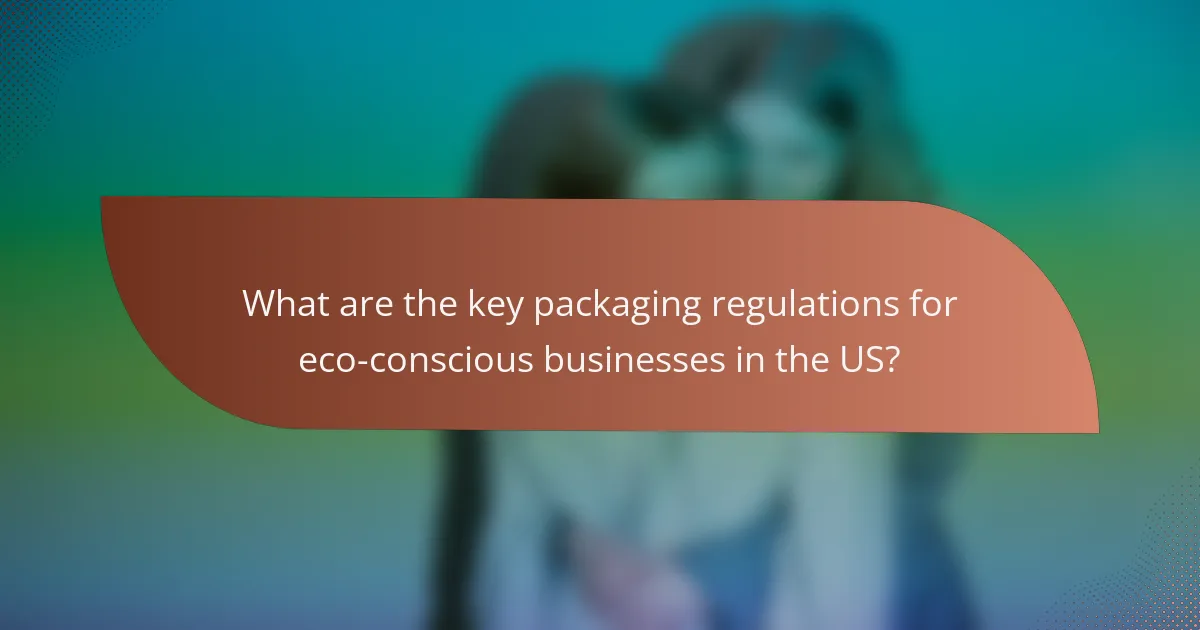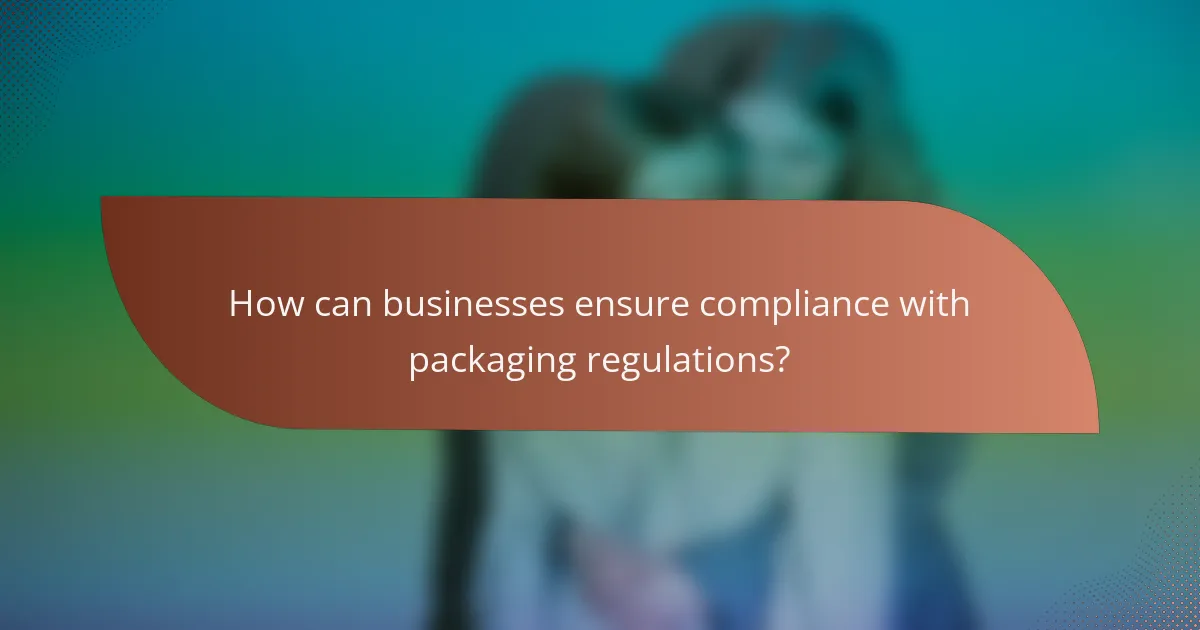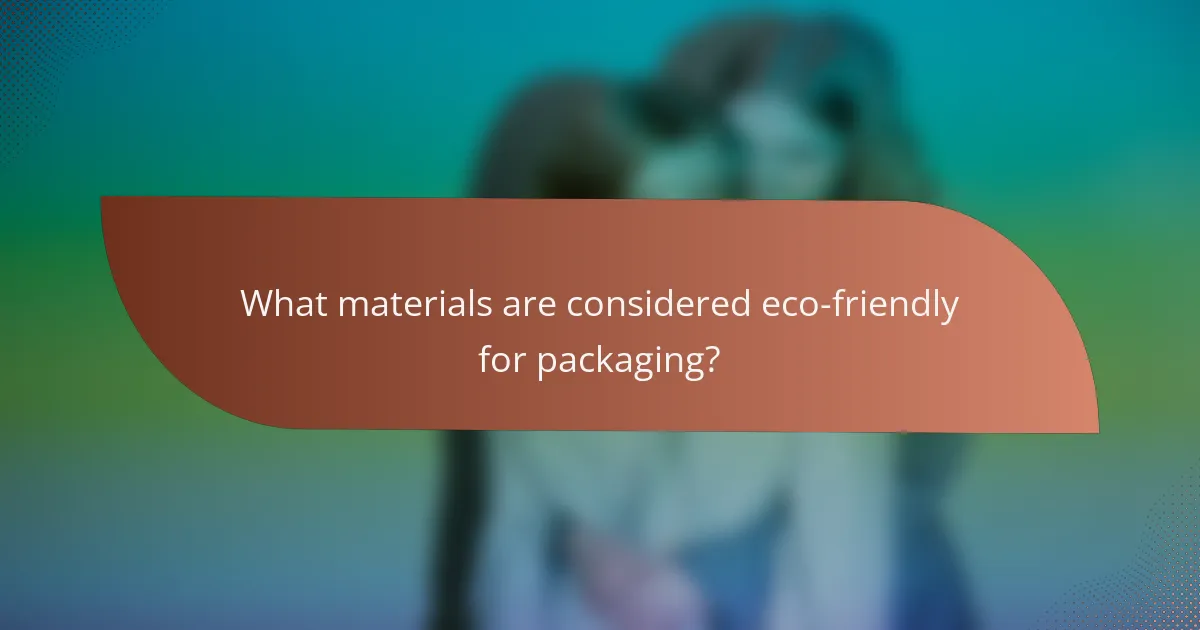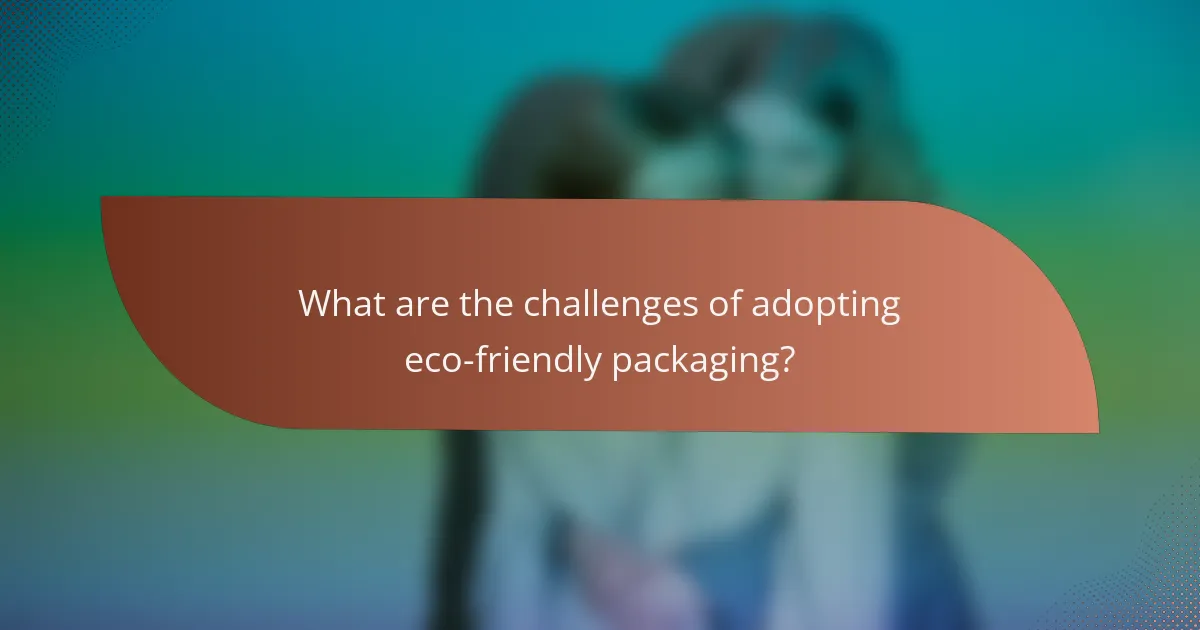Understanding packaging regulations is crucial for eco-conscious businesses aiming to promote sustainability while ensuring compliance with legal standards. In the US, these regulations encompass guidelines from the Federal Trade Commission and the Environmental Protection Agency, along with state-specific laws. By conducting audits and consulting legal experts, businesses can navigate these requirements effectively, fostering eco-friendly practices that resonate with consumers and enhance brand reputation.

What are the key packaging regulations for eco-conscious businesses in the US?
Eco-conscious businesses in the US must navigate various packaging regulations that promote sustainability and consumer protection. Key regulations include guidelines from the Federal Trade Commission, standards set by the Environmental Protection Agency, and specific laws enacted by individual states.
Federal Trade Commission (FTC) guidelines
The FTC provides guidelines to ensure that packaging claims about environmental benefits are truthful and not misleading. Businesses must substantiate any claims they make regarding recyclability, biodegradability, or sustainability to avoid potential legal issues.
For example, if a product is labeled as “biodegradable,” the business must demonstrate that it breaks down within a specific timeframe in a natural environment. Clear and accurate labeling helps consumers make informed choices while protecting the business from false advertising claims.
Environmental Protection Agency (EPA) standards
The EPA sets standards related to waste management and pollution prevention that impact packaging practices. Businesses are encouraged to adopt sustainable packaging materials and practices that minimize environmental impact, such as using recycled content or reducing packaging waste.
Companies can benefit from the EPA’s Sustainable Materials Management (SMM) program, which offers resources and guidelines for improving packaging sustainability. Participating in such programs can enhance a business’s reputation and appeal to eco-conscious consumers.
State-specific packaging laws
In addition to federal regulations, various states have enacted their own packaging laws that businesses must comply with. These laws can vary significantly, addressing issues like plastic bag bans, extended producer responsibility (EPR) for packaging waste, and specific recycling requirements.
For instance, California has strict regulations on single-use plastics, while Maine has introduced EPR laws that require producers to manage the end-of-life of their packaging. Businesses should stay informed about the regulations in the states where they operate to ensure compliance and avoid penalties.

How can businesses ensure compliance with packaging regulations?
Businesses can ensure compliance with packaging regulations by conducting thorough audits, consulting with legal experts, and implementing sustainable materials. These steps help identify requirements and avoid potential penalties while promoting eco-friendly practices.
Conduct a packaging audit
A packaging audit involves reviewing all packaging materials and processes to assess compliance with relevant regulations. This includes evaluating labeling, material types, and disposal methods. Regular audits can help identify areas for improvement and ensure adherence to local laws.
During the audit, businesses should check for compliance with recycling symbols and material restrictions. For example, certain regions may have specific bans on plastic types, so understanding local regulations is crucial.
Consult with legal experts
Engaging legal experts who specialize in packaging regulations can provide invaluable guidance. These professionals can help businesses navigate complex laws and ensure that packaging meets all necessary standards. They can also assist in interpreting regulations that may vary by region.
Consulting with legal experts can prevent costly mistakes, such as fines or product recalls. It’s advisable to seek their advice during the design phase of packaging to ensure compliance from the outset.
Implement sustainable materials
Using sustainable materials is essential for eco-conscious businesses aiming to comply with packaging regulations. This includes selecting biodegradable, recyclable, or reusable materials that align with environmental standards. Sustainable packaging not only meets regulations but also appeals to environmentally aware consumers.
Businesses should consider materials like recycled paper, plant-based plastics, or glass. Additionally, they can explore certifications that validate their sustainable practices, enhancing their brand reputation while ensuring compliance with regulations.

What are the benefits of eco-friendly packaging?
Eco-friendly packaging offers numerous advantages, including enhanced brand reputation, stronger customer loyalty, and potential cost reductions. By adopting sustainable materials and practices, businesses can align with consumer values and differentiate themselves in a competitive market.
Improved brand image
Utilizing eco-friendly packaging can significantly enhance a company’s brand image. Consumers increasingly prefer brands that demonstrate environmental responsibility, leading to a positive perception and increased trust. For instance, brands that use biodegradable materials or recycled content often attract environmentally conscious customers.
To maximize this benefit, businesses should communicate their sustainable practices clearly through marketing materials and product labeling. Transparency about sourcing and production processes can further strengthen brand credibility.
Increased customer loyalty
Eco-friendly packaging can foster greater customer loyalty as consumers are more likely to support brands that share their values. When customers feel that their purchases contribute to environmental sustainability, they are often willing to pay a premium and become repeat buyers. This loyalty can translate into long-term revenue growth.
Engaging customers through initiatives like recycling programs or discounts for returning packaging can enhance this loyalty. Creating a community around sustainability can also encourage customers to advocate for the brand.
Potential cost savings
Switching to eco-friendly packaging can lead to potential cost savings in various ways. While initial investments may be higher, many sustainable materials can reduce shipping costs due to lighter weight or smaller sizes. Additionally, companies may benefit from government incentives or grants aimed at promoting sustainable practices.
It’s essential to conduct a cost-benefit analysis to identify the most effective sustainable options for your business. Consider factors like material sourcing, production efficiency, and waste reduction to maximize savings while maintaining quality.

What materials are considered eco-friendly for packaging?
Eco-friendly packaging materials are those that minimize environmental impact, often through biodegradability, recyclability, or compostability. Businesses should prioritize materials that reduce waste and are sourced sustainably to align with eco-conscious practices.
Biodegradable plastics
Biodegradable plastics are designed to break down more quickly than traditional plastics, typically within a few months to a couple of years, depending on environmental conditions. These materials often require specific conditions, such as heat and moisture, to decompose effectively.
When choosing biodegradable plastics, consider certifications like ASTM D6400 or EN 13432, which indicate compliance with standards for compostability. However, be aware that not all biodegradable plastics will break down in a landfill, so proper disposal methods are essential.
Recycled paper products
Recycled paper products are made from post-consumer waste and can significantly reduce the need for virgin materials. They are widely accepted in recycling programs and can be used for various packaging needs, including boxes, bags, and fillers.
When selecting recycled paper, look for products with a high percentage of recycled content, ideally over 50%. This not only supports waste reduction but also encourages the recycling industry. Ensure that the paper is free from harmful chemicals to maintain its eco-friendly status.
Compostable materials
Compostable materials are designed to break down into natural elements in a compost environment, typically within 90 to 180 days. These materials enrich the soil and do not leave harmful residues, making them an excellent choice for eco-conscious businesses.
Common compostable materials include certain bioplastics, plant-based fibers, and food waste. To ensure compliance, look for certifications such as BPI or OK Compost. It’s crucial to inform customers about proper disposal methods to maximize the benefits of compostable packaging.

What are the challenges of adopting eco-friendly packaging?
Adopting eco-friendly packaging presents several challenges, including higher upfront costs and supply chain limitations. Businesses must navigate these obstacles to implement sustainable practices effectively.
Higher upfront costs
One of the primary challenges of eco-friendly packaging is the higher upfront costs associated with sustainable materials. Eco-friendly options, such as biodegradable plastics or recycled paper, often come at a premium compared to traditional packaging materials.
For businesses, this means carefully evaluating the return on investment. While the initial expenses may be significant, long-term savings can arise from reduced waste disposal fees and improved brand loyalty among environmentally conscious consumers.
Supply chain limitations
Supply chain limitations can hinder the adoption of eco-friendly packaging. Sourcing sustainable materials may be challenging due to availability issues or limited suppliers, which can disrupt production timelines.
Companies should consider establishing relationships with local suppliers who specialize in eco-friendly materials. This approach not only supports local economies but also reduces transportation emissions, aligning with sustainability goals.
